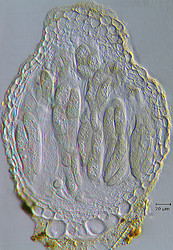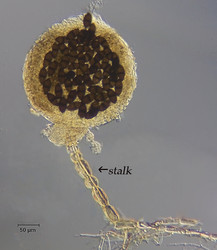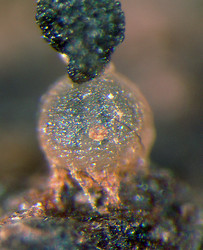Jahnulales
Aliquandostipitaceae
Carol Shearer, Huzefa A. Raja, Jinx Campbell, Astrid Ferrer, and Somsak SivichaiCharacteristics
Ascomata globose to subglobose, with a long, wide, brown, septate stalk or sessile and attached to substrate by wide (usually >10 μm), brown septate hyphae, immersed, partly immersed, or superficial, ostiolate, papillate, coriaceous to subcarbonaceous, hyaline, pale brown or black. Peridium thick, comprised of a few layers of relatively large cells. Hamathecium pseudoparaphysate, hyphal-like, filamentous, septate, unbranched between the asci, branching and anastomosing above the asci or septate, branched and persistent, separating to form cavities as asci separate from ascogenous hyphae to move upwards. Asci ovoid, cymbiform, saccate, clavate or cylindrical, thick-walled, bitunicate, fissitunicate, persistent or deliquescent. Ascospores ellipsoid–fusiform, 1-septate, becoming 3- or 4- septate at germination, apical cell slightly larger or equal in size to the basal cell, slightly or strongly constricted at the midseptum, smooth or rough-walled, with or without a gelatinous sheath, gelatinous pads, apical cellular appendages or elongated gelatinous apical appendages. Hyphae in culture wide (usually >10 μm), brown, septate unconstricted to strongly constricted at the septa. Included family: Aliquandostipitaceae Inderb.
References
Campbell J., A. Ferrer, Raja H.A., Sivichai S. and Shearer C.A. 2007. Phylogenetic relationships among taxa in the Jahnulales inferred from 18S and 28S nuclear ribosomal DNA sequences. Canadian Journal of Botany 85: 873–882.
Ferrer, A., Sivichai, S., Shearer, C.A. 2007. Megalohypha, a new genus in the Jahnulales from aquatic habitats in the tropics. Mycologia, 99 (3): 456-460.
Inderbitzin, P., Landvik, S., Abdel-Wahab, M.A., Berbee, M.L. 2001. Aliquandostipitaceae, a new family for two new tropical ascomycetes with unusually wide hyphae and dimorphic ascomata. American Journal of Botany 88 (1): 52-61
Pang, K.-L., Abdel-Wahab, M.A., Sivichai, S., El-Sharouney, H.M., Jones, E.B.G. 2002. Jahnulales (Dothideomycetes, Ascomycota): A new order of lignicolous freshwater ascomycetes. Mycological Research 106 (9):1031-1042.
Raja, H.A., Ferrer, A., Shearer, C.A. 2005. Aliquandostipite crystallinus, a new ascomycete species from wood submerged in freshwater habitats. Mycotaxon 91: 207-215
Raja, H.A., Shearer, C.A. 2006. Jahnula species from North and Central America, including three new species. Mycologia, 98 (2): 319-332.
Information on the Internet
Freshwater AscomycetesTitle Illustrations

| Scientific Name | Jahnulales |
|---|---|
| Copyright |
© Huzefa A. Raja

|
| Scientific Name | Jahnulales |
|---|---|
| Copyright |
© Huzefa A. Raja

|
| Scientific Name | Jahnulales |
|---|---|
| Copyright |
© Huzefa A. Raja

|
About This Page

University of Illinois, Urbana-Champaign, Illinois, USA
Huzefa A. Raja

University of Illinois Urbana, Illinois, USA
Jinx Campbell

University of Southern Mississippi, Hattiesburg, Mississippi, USA
Astrid Ferrer

University of Illinois, Urbana-Champaign, Illinois, USA
Somsak Sivichai

National Center for Genetic Engineering and Biotechnology (BIOTEC), Klong Luang, Pathumthani, Thailand
Correspondence regarding this page should be directed to Carol Shearer at , Huzefa A. Raja at , Jinx Campbell at , Astrid Ferrer at , and Somsak Sivichai at
Page copyright © 2009 , Huzefa A. Raja, , , and
All Rights Reserved.
- First online 09 January 2008
- Content changed 26 March 2009
Citing this page:
Shearer, Carol, Huzefa A. Raja, Jinx Campbell, Astrid Ferrer, and Somsak Sivichai. 2009. Jahnulales. Aliquandostipitaceae . Version 26 March 2009 (under construction). http://tolweb.org/Aliquandostipitaceae/29323/2009.03.26 in The Tree of Life Web Project, http://tolweb.org/












 Go to quick links
Go to quick search
Go to navigation for this section of the ToL site
Go to detailed links for the ToL site
Go to quick links
Go to quick search
Go to navigation for this section of the ToL site
Go to detailed links for the ToL site